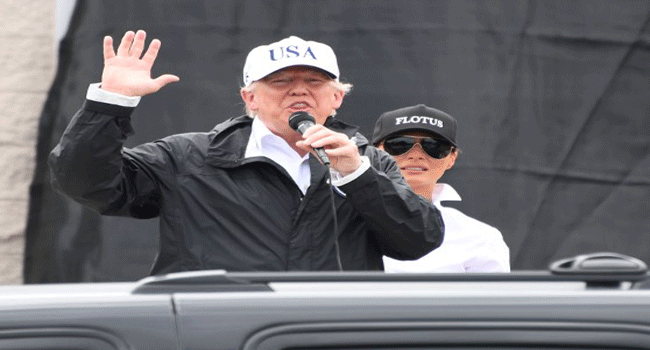
President Donald Trump flew into the Harvey disaster zone in a show of leadership on Tuesday, telling the people of Texas they “can handle anything” as the battered US Gulf Coast braced for a new onslaught from the monster storm.
Four days after Harvey slammed onshore as a Category Four hurricane, turning roads to rivers in America’s fourth-largest city, emergency crews are still struggling to reach hundreds of stranded people in a massive round-the-clock rescue operation.
Sporting a “USA” baseball cap and clutching a Texas flag, Trump sought to strike a unifying tone as he visited the coastal city of Corpus Christi, praising the work of state and federal officials in responding to the first natural disaster of his presidency.
“We want to be looked at in five years, in 10 years from now as, this is the way to do it,” he said.
Emerging from a briefing held inside a local fire station, Trump climbed up a ladder for an impromptu address to the mix of supporters and banner-waving protesters gathered outside.
“We love you, you are special, we are here to take care of you,” the president called out. “It’s historic, its epic, but I tell you, it happened in Texas — and Texas can handle anything.”
“What a crowd, what a turnout,” he added.

But the president was nevertheless seeking to make a political statement, learning from the mistakes of former Republican leader George W. Bush, whose response to Hurricane Katrina — which walloped New Orleans exactly 12 years ago — was widely seen as botched.
Harvey has so far driven more than 8,000 people into emergency shelters across the Lone Star State, and hundreds more still await rescue.
“We’re Trumponites. I trust he’s going to take care of us,” said Darla Fitzgerald, a 58-year-old nurse based in a Red Cross shelter in Winnie, a small town east of Houston, where the rain fell heavily Tuesday.
– One more victim –
A Houston police officer was confirmed Tuesday as the latest victim of the storm: the body of Steve Perez, who went missing after reporting for duty in the early hours of Sunday, was recovered by divers two days later.
Harvey was previously known to have left at least three people dead, with six more fatalities potentially tied to the storm, and officials warned the danger has far from passed.
Rising floodwaters breached a levee in Brazoria County south of Houston, with officials urging residents of the 50 homes in the immediate vicinity to leave immediately.
“The levee at Columbia Lakes has been breached!!” the county government tweeted. “GET OUT NOW!!”
The US Army Corps of Engineers has already moved to open the Addicks and Barker dams — under pressure from what the agency has dubbed a “thousand-year flood event” — to prevent a catastrophe on the outskirts of Houston.
With neighboring Louisiana squarely in the storm’s path, Harvey, now a tropical storm, is pressing eastward and is expected to make landfall again late Tuesday or early Wednesday.
Residents of low-lying New Orleans — which bore the brunt of Katrina’s wrath in 2005 — are bracing for up to 10 inches of rain over the next 36 hours, with a risk of flash floods.
“It is really sort of a wild card right now,” meteorologist Eric Holthaus told AFP of the outlook for New Orleans.
As of Tuesday morning, two inches of rain had already fallen over the city famous for its jazz music and Cajun cuisine — but particularly vulnerable because it lies below sea level.
– ‘Not over’ –
The National Weather Service tweeted Tuesday that Harvey appears to have broken a US record for most rain from a single tropical cyclone, with 49.32 inches (125.27 centimeters) recorded at a gauge southeast of the city.
“The single greatest threat continues to be the rainfall,” Dennis Feltgen, a spokesman for the Miami-based National Hurricane Center, told AFP.
“This is not over,” he said.
The Texas bayou and coastal prairie rapidly flooded after Harvey struck the coast on Friday, but the region’s sprawling cities where drainage is slower were worst hit.
Highways were swamped and homes were rendered uninhabitable, with power lines cut and dams overflowing, sparking massive floods across Houston — a city of 2.3 million people — and its wider metropolitan area of six million.
Sixteen-year-old Andrea Aviles was holed up at a hotel with about 30 members of her extended family, having evacuated her home in Winnie earlier Tuesday, driving past cars abandoned in flooded ditches on the way.
“All our yard is full of water,” said Aviles. “I’ve never seen it like this.”
Houston can expect two to four more inches of rain as the storm moves away, but flooding will likely linger through the week.
Federal officials estimate that up to half a million people in Texas will ultimately require some form of assistance — but for now the focus remains immediate disaster relief, with many lives still at stake.
“Recovery is a slow process,” Brock Long, the head of the Federal Emergency Management Agency, said as he welcomed Trump in Corpus Christi along with Texas Governor Greg Abbott.
“We’ve got a long way to go,” Long said.
AFP


No comments:
Post a Comment